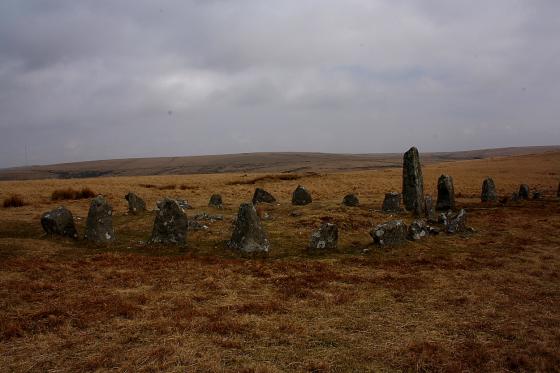Heading downhill from Corringdon Ball stone row (30.8.2010), East Glaze Brook proves to be narrower and faster flowing than its western namesake, the water forced into a little fall by the granite rocks on its sides. Luckily it’s not wide enough to cause any real obstacle to progress. The long barrow, a skyline landmark for some time, has now disappeared beyond the brow of the hill.
There is apparently another stone row between brook and barrow, but my cursory look doesn’t reveal it and by now I am quite tired and hot, and still not quite at the furthest point out of the day, so I don’t press the point as much as perhaps I should.
Cresting the ridge, the slumped shape of the long barrow comes back into view. A real rarity on Dartmoor, this wrecked chambered long mound would readily recognise its Cotswold cousins, the principal difference being the much harder granite of its construction. Unfortunately, like many of its family it has been trashed. The chamber is now reduced to a collection of scattered stones, leaning and fallen uprights and a dismounted slab that was presumably the capstone. Cattle clearly trample around the remains, probably making rubbing stones from the uprights. The earth around the stones is being very badly eroded by these visitations. The mound itself is low and stands to a height of less than a metre. An even more trashed and reduced round barrow, cut across by a wall, sits quietly to the southeast. Despite all of this, the long barrow remains surprisingly impressive, partly due to its positioning against the skyline when seen from both east and west. The endless skies of Dartmoor and the solitude of this spot, far away from roads or houses, contribute to a strong sense of timeless place that many barrows in better states of preservation elsewhere lack. As ever on Dartmoor, I find it very difficult to imagine a woodland landscape in place of the wide open spaces of the moor. What change this mound has seen over the ages!
I spend a while here, in silence and solitude, but it’s a long, hot walk ahead and at length I return over East Glaze Brook to collect G/F. We head back to the old tramway bed at Glasscombe Ball, which as part of the Two Moors Way will take us all the way back to Ivybridge. It’s been a terrific day out, the Neolithic survivors at Cuckoo Ball, Butterdon Hill and Corringdon Ball, although less celebrated and visited than the numerous Bronze Age sites, remain an important and rewarding collection of Dartmoor sites to visit.







































































































































































































































